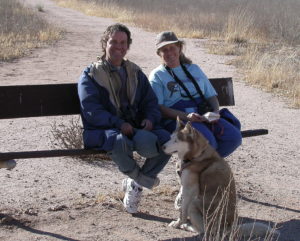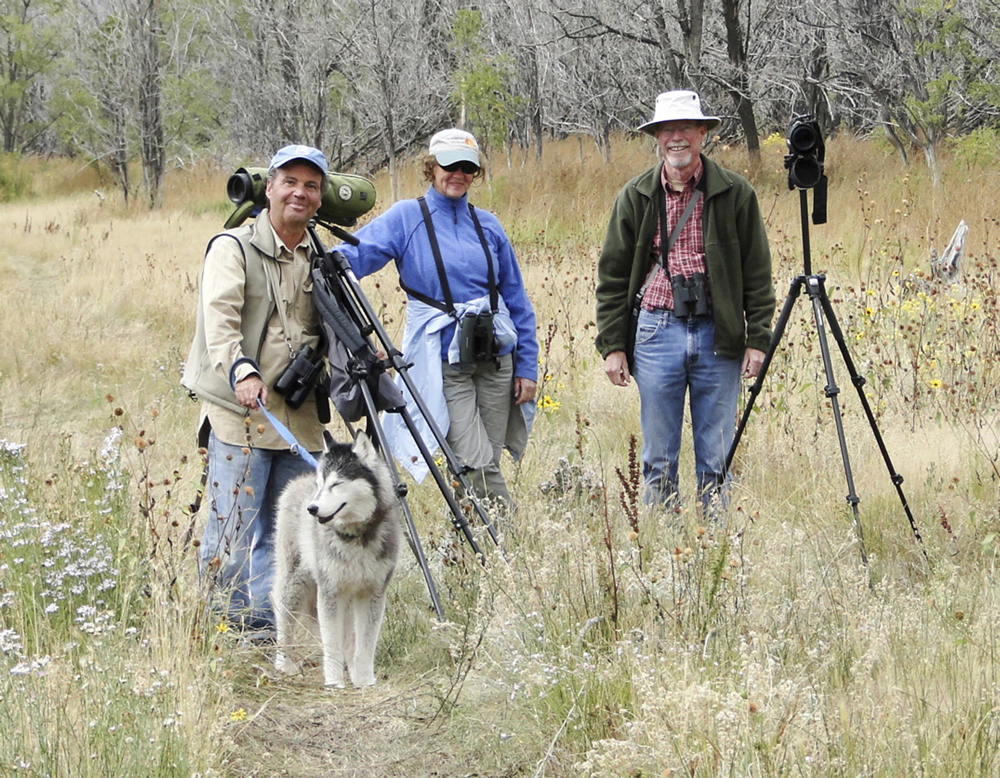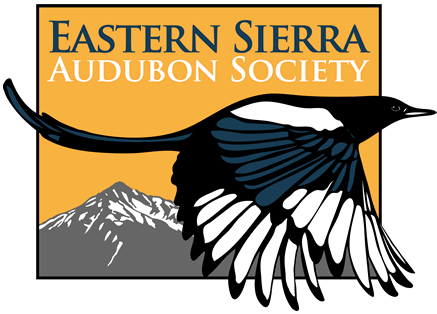
Jim and Debby Parker on Dec 29, 2002 near the San Pedro house in Sierra Vista, Arizona.
We were lucky enough to get to spend a week together tracking down so many rarities that were present in AZ that winter. Many days started out near freezing but it warmed into the low 70s and we spent every daylight hour birding. I think we eventually got all of the rarities that we knew about, plus a few more. Debby got some great photos of the fairly newly discovered Black-capped Gnatcatchers that were at Lake Patagonia that winter. It was a great trip that I will always remember!
Kelli Heindel-Levinson, Bakersfield, CA
As in every group, there are some individuals whose contributions are extraordinary. The Eastern Sierra has such a couple, Jim and Debby Parker, and since they are leaving us we wanted to take this opportunity to remind everybody just how much they have contributed to the community, especially the avian history of Inyo County. Jim and Debby’s first recorded bird sighting for Inyo County was when they found a Ross’s Goose at Millpond County Park 22 March 1992 and they’ve come a long, long way since then. We know of no other birders, field ornithologists, or professional researchers in Inyo County who have been in the field as many hours as they have, or have written more descriptions than they have, or have prepared four seasonal reports every year as they have, or have called more people to come out and see another fancy bird they just found, or after a decade of learning spent the following decade sharing their knowledge in weekly bird field trips, or helped develop and implement the Birds in the Classroom program to get kids turned on to birds and then gathering a number of volunteers to take the kids to birding areas where they could find and identify the birds themselves, or writing bird identification articles for the WAVE, and more and more and more.

Jim Parjer with Kathy Duvall and Bill Mitchel in Round Valley. Photo by Nancy Overholtz.
Being active birders isn’t what sets them apart because there are many active birders. It’s the level to which they rose in becoming reliable, thoughtful, knowledgeable, and cautious contributors to the body of avian knowledge in Inyo County. Few write as comprehensive descriptions of birds as they do with citations from the sources they accessed to answer their questions and provide them with identification information. In fact, we only know of one other person and he is a professional ornithologist! They have amassed a huge inventory of photographs/images to document their claims. Their intellectual curiosity stimulated them to try to age and sex every bird they saw, which has allowed a far more complete “calendar” of when young and adults and males and females are usually found in Inyo County. They embraced the challenge of trying to determine which subspecies they were looking at and photographing and then spend non-birding time–nighttime–studying the literature to make those determinations. Sometimes they decided there wasn’t enough information for them to be sure so they didn’t claim any subspecies. When the Sage Sparrow was taxonomically split into Sagebrush and Bell’s Sparrow, they looked at all their images and, using the new identification tools that were provided, identified each image to its new taxon. A couple of times they made a claim, publically, and after continued study of the bird and input from others viewing the bird they changed their mind and recanted their claim, publically! It is more important to them that the truth be known than they indulge in the protect–my–reputation/ego game some birders play. Because of this character trait, others outside our Eastern Sierra group highly respect Jim and Debby and value their data as extremely reliable.
The incredible sinking Debbie
We were out birding the meadow and we’re walking across the wet area. Debby and I were shoulder to shoulder when suddenly she disappeared. I looked back and she is stuck in a sink hole up to her armpits. I say a big exclamation !#@%&**! that Debbie found so funny she burst out laughing. Like any true birder/photographer, she is worried about her optics. After I take all that she manages to worm her way out and is a soaking wet mess and still laughing at what I said and the look on my face.
~ Susan Steele
Near the beginning of their tenure in Inyo County, they expanded their backyard to include Birchim Canyon located just south of Sherwin Grade near the Mono County line. As the years accumulated, so too did the bird records from there and so too did the interest in the area by outsiders who seldom read a seasonal report in North American Birds without being reminded of the fancy birds that the Parkers had found there. It became a regular stopping spot for visitors heading north or south on Hwy 395. The data that Jim and Debby gathered in Birchim Canyon easily exceeds all other data from there gathered by everybody else…and it is data you can bank on. Any serious birder or researcher working on the birds of the Eastern Sierra needs to take a serious look at their two decades of bird data gathering that is becoming available on eBird and their data includes far more than just this special canyon.
After painting my first bird, I realized I wanted to learn more about them and photograph them. So in October of 2005, Ron and I went on our first Audubon field trip with Debby around the Meadowcreek area in Bishop. I can’t believe I never noticed a Spotted Towhee before but I sure did when I looked at one through binoculars for the first time. Debby is an incredible birder and teacher. Then Jim retired and we acquired another great mentor. The phrase repeated most in our life lists is “found by Jim and Debby Parker”. Thanks to both of you for making our lives more meaningful.
~ Nancy and Ron Overholtz, Bishop, CA
The Inyo County Avian Database contains almost 400,000 entries that answer questions regarding the earliest and latest seasonal records, highest and lowest records, average daily count and maximum number of birds seen in a day, first county record, and breeding data. Considering that almost 1000 observers have supplied all the county data the average is 400 bird records per observer. The Parkers, via their seasonal reports which are ONLY their rarest species, species of special concern, unusual dates/locations/elevations of common species, and breeding data, have contributed about 5000 records to the county database. This is a small percentage of all the data they have collected!!! They compiled comprehensive lists for each day in the field with “written in the field” descriptions and photos of sightings that they recognized as being extraordinary. When in doubt, they left it out. They don’t expect current reviewers to accept their raised–hands, “We had that!” claims and certainly don’t expect those a century from now to rely on anything except the evidence they and other observers have left behind.
The magnitude of their efforts is hard to fathom but here is a peak at some of what they have left behind:
- They added five bird species and one sub-species to the Inyo County bird list–all photographed of course:
- Trumpeter Swan 8 January–3 February 1999 at Pleasant Valley Reservoir
- Dark-eyed (White-winged) Junco 12 December 2000 southeast of Bishop was the third record of this subspecies for California
- Eurasian Collared-Dove 8 March 2002 in Bishop
- Mew Gull 8–10 May 2003 at Bishop City Park
- Eastern Wood-Pewee 22–26 October 2011 in Birchim Canyon
- Great Crested Flycatcher 6 September 2012 in Birchim Canyon
- They have the second through ninth records of seven vagrants with ten or fewer county records (White-eyed Vireo, Yellow-throated Vireo, Golden-winged Warbler, Blue-winged Warbler, Yellow-throated Warbler, Canada Warbler, and Scarlet Tanager).
- They have the earliest ever spring arrival dates for 11 species (Osprey, Black Tern, Forster’s Tern, Black-bellied Plover, Black-and-white Warbler, Cape May Warbler, Blackpoll Warbler, Palm Warbler, Black-throated Gray Warbler, Clay-colored Sparrow, and Grasshopper Sparrow).
- They have the latest ever spring departure dates for nine species (Greater White-fronted Goose, Whimbrel, Hammond’s Flycatcher, Northern Parula, Black-throated Gray Warbler, Townsend’s Warbler, Slate-colored Fox Sparrow, Baltimore Oriole, and Tricolored Blackbird).
- They have the earliest ever fall arrival dates for nine species (Greater White-fronted Goose, Black Tern, Red Knot, Red-eyed Vireo, American Redstart, Chestnut-sided Warbler, Black-throated Gray Warbler, Western Tanager, and Common Grackle.
- They have the latest ever fall records for 14 species (Osprey, Solitary Sandpiper, Calliope Hummingbird, Vaux Swift, Willow Flycatcher, Hammond’s Flycatcher, Dusky Flycatcher, “Western” Flycatcher, Warbling Vireo, Black-and-white Warbler, Hermit Warbler, Tennessee Warbler, Indigo Bunting, and Common Grackle).
- They have the highest elevations for two species (Blue Grosbeak and Tricolored Blackbird).
- They have the first ever winter record for Lark Bunting.
They have decided that it is time to return to Mt. Shasta in northern California to be close to family. While we regret their decision, we respect it and all that they have done for Inyo County and the birds that occur here. Their absence will be a great loss, but how fortunate are those who will benefit from the new discoveries and contributions they will make in their new home. Bon Voyage and Good Luck to Jim and Debby Parker, whose names will forever be entwined with Inyo County avian history.
One Last Story…
For over 20 years, local birders banded together to study, chase, photograph, and tick Inyo County birds. This Bird Study Group was involved in taking trips together locally, out of state, and even a few out of the country. The Parkers were important and valuable participants in many of the in and out-of-state trips and contributed to the many successes and laughs we all had while adding birds to our life and state lists.
We remember well, with broad smiles, one trip to Texas. Birders, really serious birders, get up before the sun does to grab a breakfast that will keep them going while they behave like kids running around trying to find birds. There was only one restaurant in town that opened early enough for us. The infamous Waffle House. In the pre-dawn morning we drove to the restaurant, whose lit-up sign lacked the first letter of the first word, and after eating there decided that the “new” name was appropriate. Jim greeted the group the following morning with, “we’re off to the awful house!” which became the morning reveille during our stay.
At the next group meeting back in Big Pine, Jim arrived to serve his favorite awful house food, grits, while wearing a paper cap he had charmed from one of the workers at the Waffle House! Thanks for so many memories!!
~ Tom and Jo Heindel, Big Pine, CA
Tom and Jo Heindel have contributed a vast amount of their knowledge to the Wave Newsletter over the years (from 1993 on!). Those articles have been archived for reference, here: Heindel’s articles and season highlights.
Tags: blackbird, egret, gnatcatcher, lark, oriole, osprey, plover, sandpiper, warbler


